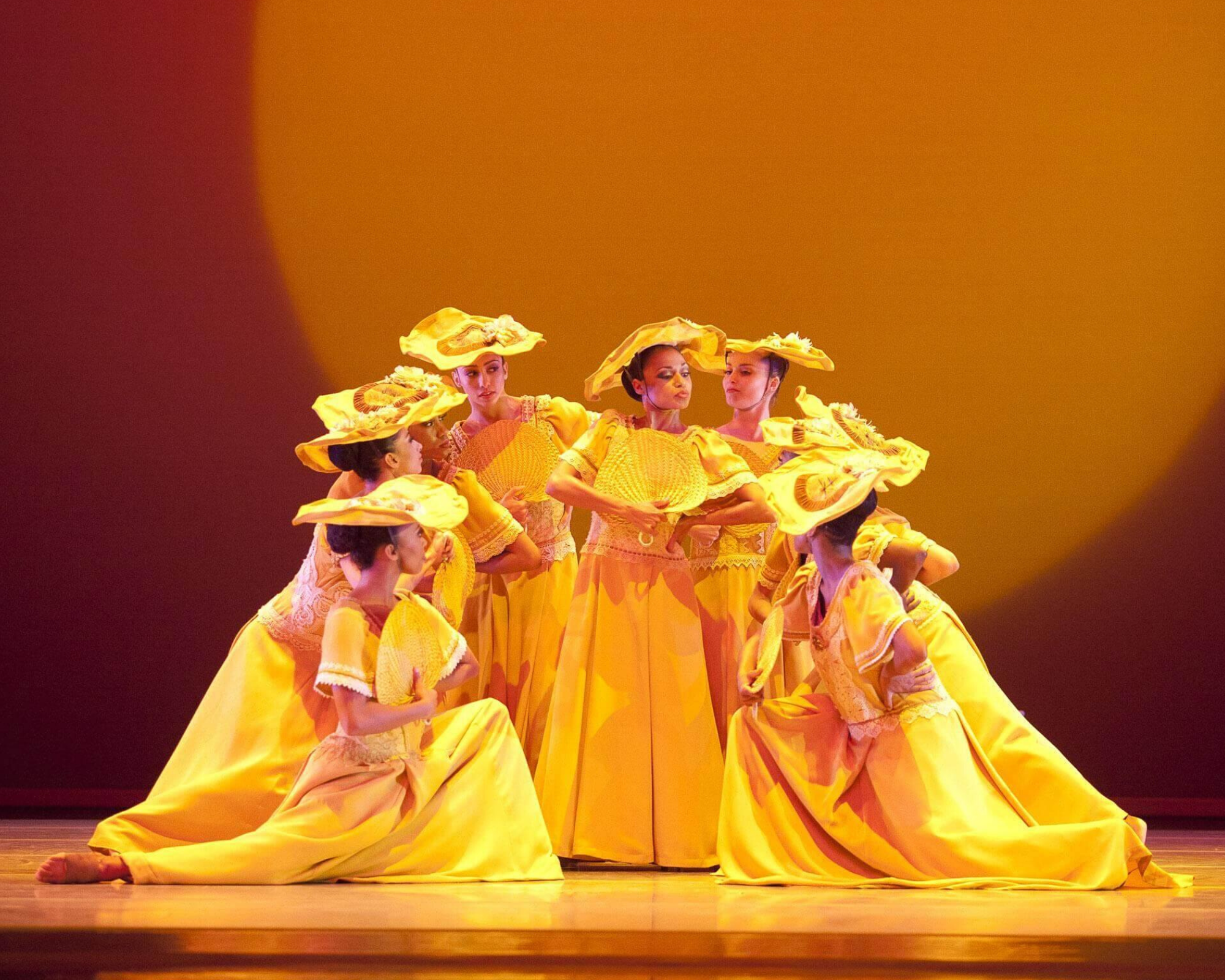Hancher Auditorium was filled with profound movement and power by the dance company, as the audience grapples with the uncertainty of the days to come.
Feature image photo by Gert Krautbauer. Courtesy of Alvin Ailey American Dance Theater.
If you are familiar with modern dance, there is an excellent chance that you have heard about or seen Alvin Ailey’s Revelations. Since viewing portions of this piece in college, I have placed Revelations on a pedestal I reserve for works I highly regard. I don’t think I am alone in that since the piece premiered in 1960 and it still graces the stage 60 years later.
While I was eager to go to this performance, going felt a bit off. It was only two days earlier that Iowans discovered that COVID-19 had made it to our state. At that point, there were only a handful of cases. Fear and anxiety had just started to pour in.
When I made my way to my seat, I felt lucky that the green, plush seat to my right was empty. I leaned to the right side of the chair—not to rest my arm, but to create as much distance between my seat neighbor and myself. It wasn’t much, but it was what I did to keep myself safe as best I could under the circumstances.
By the end of the show, I was on the edge of my seat — not toward the right in an effort to escape potential transmission, but toward the front edge of my seat from the triumph and elation I felt watching this performance.
The Alvin Ailey American Dance Theater performed Revelations, Busk, and Ode at Hancher Auditorium on March 10.
Busk—the Oxford dictionary defines this word to mean to perform in streets, subways or other public places for donations—was choreographed by Aszure Barton and started the evening. Barton has choreographed for more than 25 years and created work with English National Ballet, Nederlands Dans Theater, National Ballet of Canada, and Martha Graham Dance Company to name a few, as noted in the evening’s program.
This piece had an ominous beginning. All the dancers wore baggy, black clothing with a theatrical haze that floated on stage. One dancer began moving and tumbling while wearing white gloves, reminiscent of a mime, and a hat — that the other dancers passed around during the early stages of the dance.
Busk took a moment to resonate with me, perhaps with the anticipation I had for Revelations, which was at the end of the concert. Any thread of doubt I had about the merit of this piece entirely dissipated as a female soloist ate up the entire stage.

To enter her solo, she removed her baggy sweatshirt. It wasn’t a clumsy removal. As her arms reached for the hem of the shirt, she floated the sweatshirt off her torso.
The golden stage lights shimmered on her skin and highlighted the definition of her back muscles. Those were the same back muscles that made her arms ripple through each position.
“She was ripped,” said Emily Buttolph, a fourth-year dance and English major. “Her arms encompassed the entire stage.”
One of her most astounding moments was when she stood upon one leg and tilted her chest toward her standing leg. She teeter-tottered over so that her legs were in a 180° split while standing. She repeated this motion on the top stair of the staircase that was moved around the stage through the piece.
The unison moments of the piece brought large jumps with swinging arms. The 13 dancers would do bounding stag leaps—an apt name for this leap since the position of the legs resemble that of a jumping deer —as their arms mimicked the pendular motion of a grandfather clock.
When they weren’t springing in place on the stage, they were often collected in a tight clump seated on the floor. They morphed into one shape since the baggy, black clothing hid the divisions of their bodies.
In this position, they undulated from one side of the clump to the other. They sat up to a straight-backed seated position and jutted their heads backward and forward, reminiscent of chickens looking around their coop.
While the moments of unity were quite physically and visually impressive, the solos were the standout moments of the piece by far. They stood out partly because they were performed without the black tops, but mostly because of the impressive technical prowess each soloist utilized.
The sound score of a male soloist’s piece was fascinating. It featured the sounds of a ping pong ball bouncing and a tap dancer shuffling away. The reaches of his arms toward the floor lined up perfectly with the bounces of the ping pong ball in the sound score.
As this physically challenging and unison testing piece came to an end, the audience delivered a hailstorm of applause. The dancers reciprocated not with a gratuitous bow, but a slow controlled bend of the torso. This bow radiated the confidence and professionalism that this prestigious company brought to the rest of the show.

Ode, choreographed by Jamar Roberts, resident choreographer of Alvin Ailey Dance Theater, appeared on stage next with a cast of all women. Upon the black background was a net covered in a floral design cascading from the top of the stage to the ground.
This piece took a moment to resonate with me as well, since I spent the first few moments of the piece darting my eyes around the room to find the source of an eruption of coughs.
My worry dissipated as the dancers’ ombré dresses twirled and wrapped around them, as performers burst unto the stage.
This piece highlighted the musicality that the choreographers and dancers utilized throughout the night. The music that accompanied this piece had quite dissonant moments, that were sometimes hard to listen to, but that might have been the point.
This piece was an ode to, “the innocent victims of gun violence and a meditation on the beauty and fragility of life,” the program for the evening explained.
Gun violence, fragility of life and innocent people dying are not easy to take or understand, which the music exemplified.
However, the choreographer found moments in the music where a piano key would tink, and the dancers would reach or fall at that exact moment. Other times, the dancers would push the tempo and keep moving at an extraordinary rate, to a point where I wondered if they could move that fast for any longer. This coupling of music and movement came together to create a sense of comfort, like a hug from a loved one.
Finally, the anticipation was over for the evening; Revelations came to the stage. For approximately 30 minutes, the world was away. I forgot about the moment before the show when the women next to me asked if I was healthy.
Tears welled in my eyes three times, once every ten minutes. My vision blurred with unshed tears not from worry of the days to come, but from the pure splendor of art.
It is hard to isolate the standout moments of this piece because each moment was as grand as the next. Although, it was clear that the audience was blown away by Sinner Man, a separate portion of the piece with three male dancers.
They completed mystifying feats over and over. They ran on stage performing variations of a tuck jump. Yet, these jumps did not just ascend; they floated. These massive, gravity-defying jumps elicited roars of applause from the audience, giving us a sense of excitement and tension.
Rocka My Soul in the Bosom of Abraham was the final song performed in this piece. This portion began with the audience seeing an orange circle in a yellow background to resemble the sun on a bright, simmering southern Sunday morning.
The women wore yellow dresses with matching hats and fans; the men adorned in their Sunday best with corresponding yellow accents.
As these bright yellow outfits spun around the stage, the dancers exuded enthusiasm and joy. The women whipped their fans around themselves with great specificity, and the men tapped and stepped their feet with the same specificity and a syncopated rhythm.
The piece ended and with jubilance they repeated the last section—this time with the audience standing and clapping along. As the second rendition came to an end, the audience wouldn’t stop clapping. Although, the dancers were prepared with an elaborate sequence of bows to occupy the minutes after the show that the audience filled with applause.
There is no way to describe all the impactful moments of Revelations, especially as it was a dream of mine to see it in person. While there isn’t a way in my mind to quantify the staggering quality of this piece, it can be felt with the emotion and power that it held for all the audience.
In this time of unpredictability, find the art that has the power to call you back to your humanity, just as Revelations did for me and many others that night in Hancher Auditorium.

